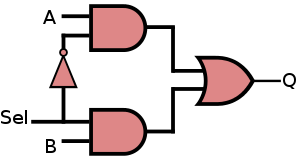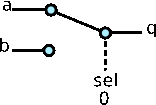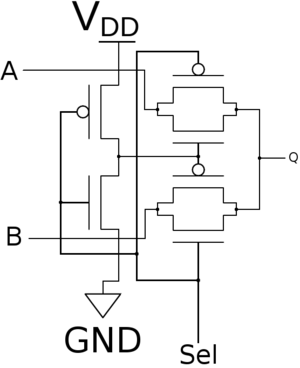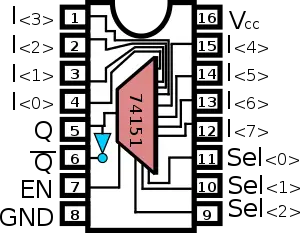| Multiplexer | ||||||||||||||||||||||||||||
| Typical Symbol (2:1 MUX) | ||||||||||||||||||||||||||||
| Functional | ||||||||||||||||||||||||||||
| Truth Table | ||||||||||||||||||||||||||||
| ||||||||||||||||||||||||||||
| ||||||||||||||||||||||||||||
| ||||||||||||||||||||||||||||
A multiplexer (mux) or a data selector or input selector is a combinational circuit device that selects one of N inputs and provides it on its output. A set of inputs called select lines determine which input should be passed to the output. For a 2:1 (two-to-one) MUX, when sel is 0, q = a and when sel is 1, q = b. A multiplexer with 2N input lines requires N select lines.
Multiplexers are useful in any application in which data must be chosen from multiple sources to a single destination. Multiplexers are also heavily used in I/O operations, data buses, and register files. Additionally multiplexers have also found their way to various other circuits such as adders.
Contents
[hide]Description
 A multiplxer is a device that receives multiple inputs from usually different sources. A set of select lines are then used to choose which of those inputs gets produced as output. Signals to the select lines usually come from a control unit that determins which, if any, of the signals should be routed to some destination. MUXes are core components in most digital systems as they can be used to pass the correct signal based on some conditional logic. For example, consider a data bus that is connected to multiple memory storage units. One can use a multiplexer to select which of those lines should be going to the shared data bus.
A multiplxer is a device that receives multiple inputs from usually different sources. A set of select lines are then used to choose which of those inputs gets produced as output. Signals to the select lines usually come from a control unit that determins which, if any, of the signals should be routed to some destination. MUXes are core components in most digital systems as they can be used to pass the correct signal based on some conditional logic. For example, consider a data bus that is connected to multiple memory storage units. One can use a multiplexer to select which of those lines should be going to the shared data bus.
Enable
It's often desirable to add an enable (or strobe) input EN to a multiplexer. An enable input makes the multiplexer operate. When EN = 0, the output is either LOW or High-Z (depending on the specific device). When EN = 1, the multiplexer performs its operation depending on the selection line.
Variations
Many different variations of multiplexers exist. Typically larger multiplxers (over 8 or 16 inputs) are built using smaller multiplxers using a multiplexer tree.
2:1 Mux
A 2:1 Mux is the simplest multiplexer that can be made. Its selection lines are made of a single bit. A truth table is provided on the right. The logic function of a 2:1 Mux is: Q=(A ∧ S) ∨ (B ∧ S)

|
| ||||||||||||||||||||||||
Very fast, CMOS-based, 2:1 Mux devices can be built using two transmission gates as shown below. Note that the implementation below is a nonrestoring multiplexer.
4:1 Mux
| Sel<0> | Sel<1> | I<0> | I<1> | I<2> | I<3> | Q |
|---|---|---|---|---|---|---|
| 0 | 0 | 0 | X | X | X | 0 |
| 0 | 0 | 1 | X | X | X | 1 |
| 0 | 1 | X | 0 | X | X | 0 |
| 0 | 1 | X | 1 | X | X | 1 |
| 1 | 0 | X | X | 0 | X | 0 |
| 1 | 0 | X | X | 1 | X | 1 |
| 1 | 1 | X | X | X | 1 | 1 |
| 1 | 1 | X | X | X | 0 | 0 |
A 4:1 Multiplexer is a common multiplexer that takes selects one input among 4 and connects it to its output based on a 2-bit select line. There are many way to construct a 4:1 Mux, one possibility is using 2:1 Mux as shown below:
Alternatively, a 4:1 Mux can be built out of basic gates. Its function is shown below:
Q =
Where A, B, C, and D are the four inputs. Q is the output.
Larger Multiplexers
Multiplexers generally only come in a few common sizes. Even in ASIC design, arbitrary sized multiplexers are not always offered. Large multiplexers can always be built from a collection of smaller ones. Consider a register file with 32 registers where we only want to select a single register at any given time. Such multiplexer can be design from four 8:1 Mux.
74151 - 8:1 Mux
A common multiplexer is the 8:1 Mux which selects one of 8 bits of input. The 74151 is a popular 16-pin DIP IC that implements an 8:1 mux. Note that the implementation below is an active-low.
To the right is the typical schematic of the 74151, 16-pin DIP IC. Vcc is on pin 16 and GND is on pin 8. Pins 5 and 6 are the outputs, the output on pin 6 is the inverted version of the output on pin 5. The enable is on pin 7.
| 8:1 Mux | |||||
|---|---|---|---|---|---|
| Inputs | Output | ||||
| Select | Enable | ||||
| Sel<0> | Sel<1> | Sel<2> | EN | Q | Q |
| X | X | X | 1 | 1 | 0 |
| 0 | 0 | 0 | 0 | I<0> | I<0> |
| 0 | 0 | 1 | 0 | I<1> | I<1> |
| 0 | 1 | 0 | 0 | I<2> | I<2> |
| 0 | 1 | 1 | 0 | I<3> | I<3> |
| 1 | 0 | 0 | 0 | I<4> | I<4> |
| 1 | 0 | 1 | 0 | I<5> | I<5> |
| 1 | 1 | 0 | 0 | I<6> | I<6> |
| 1 | 1 | 1 | 0 | I<7> | I<7> |
Tri-State Outputs
Some commercial multiplexers have tri-state outputs. When the EN input is LOW, instead of the output being forced into 0, it gets forced into a Hi-Z state.






